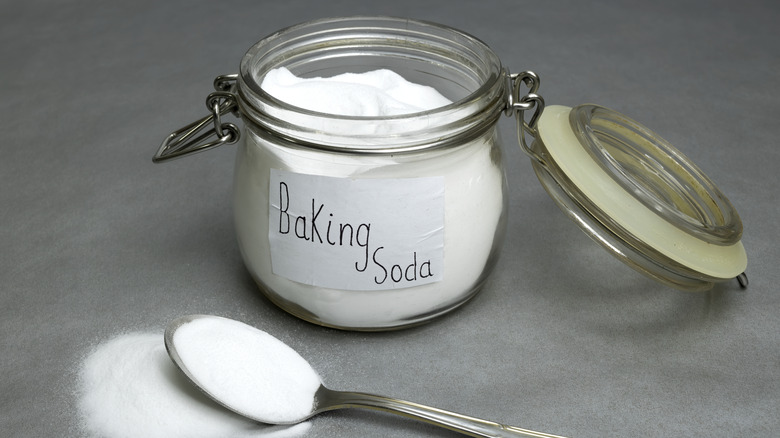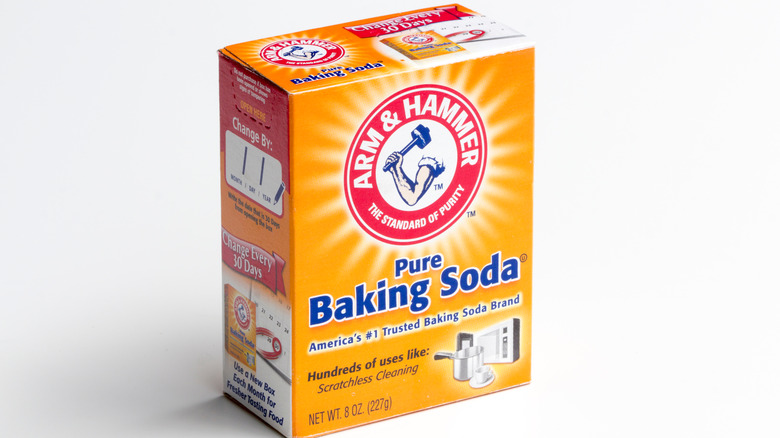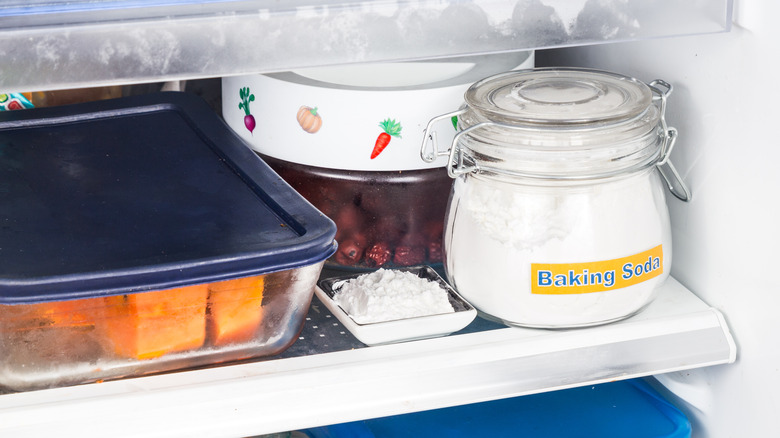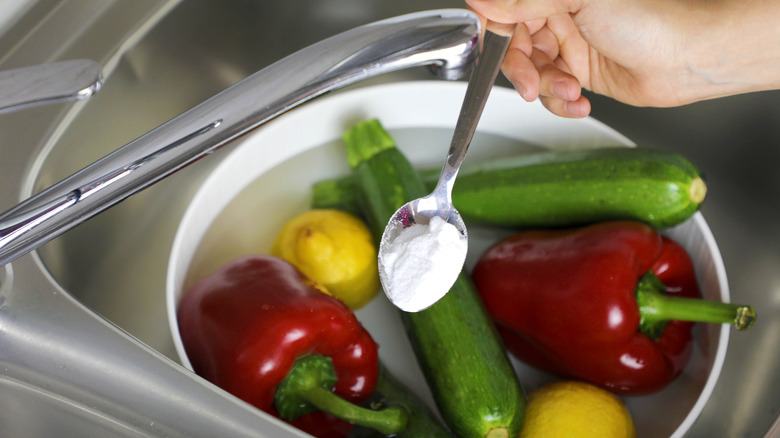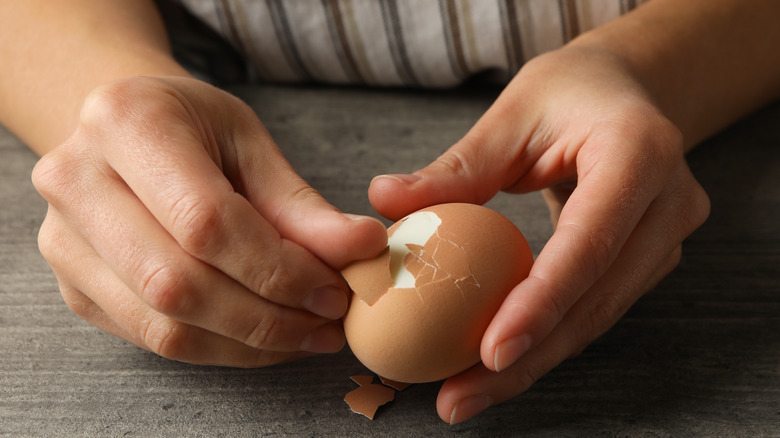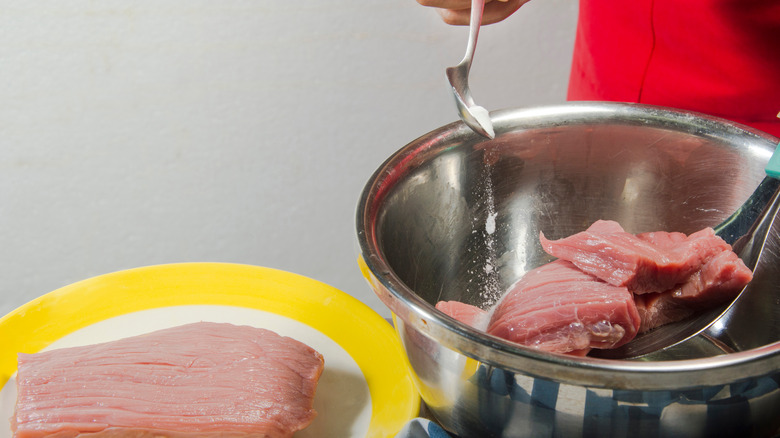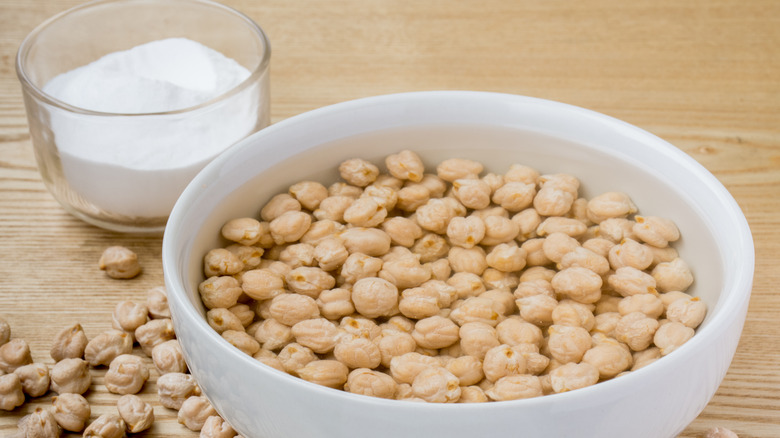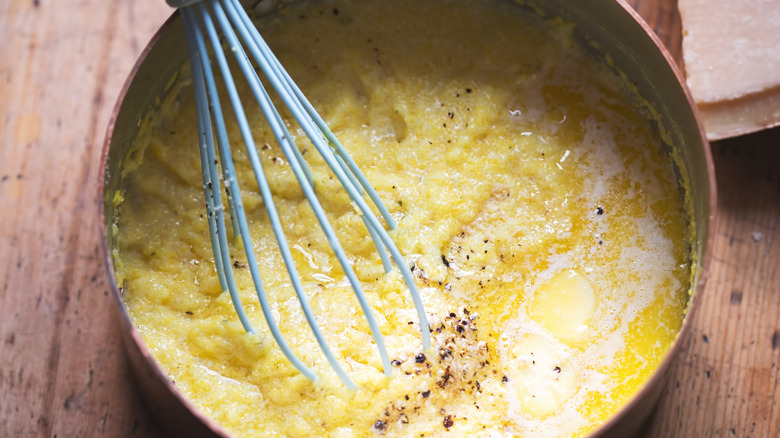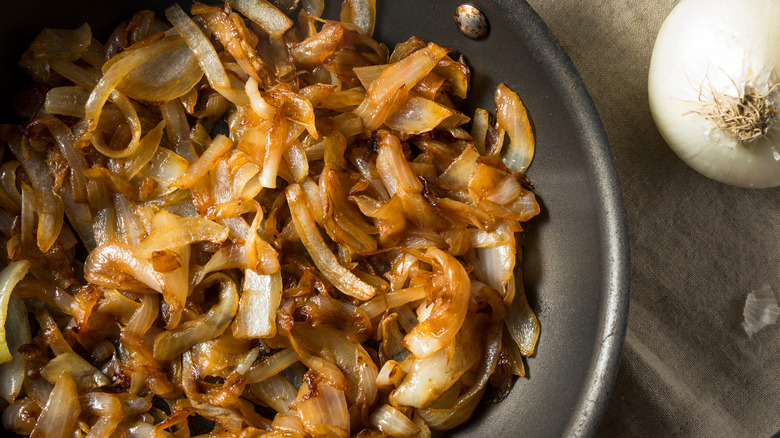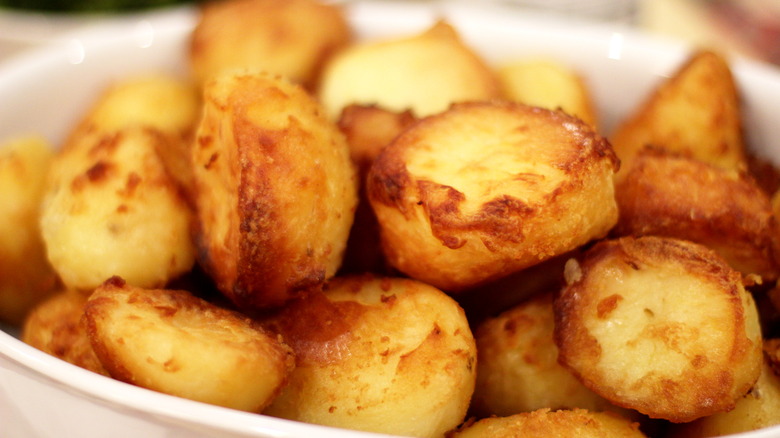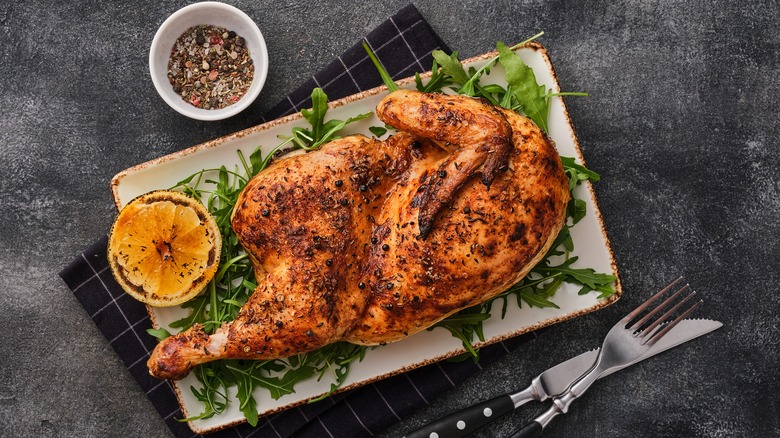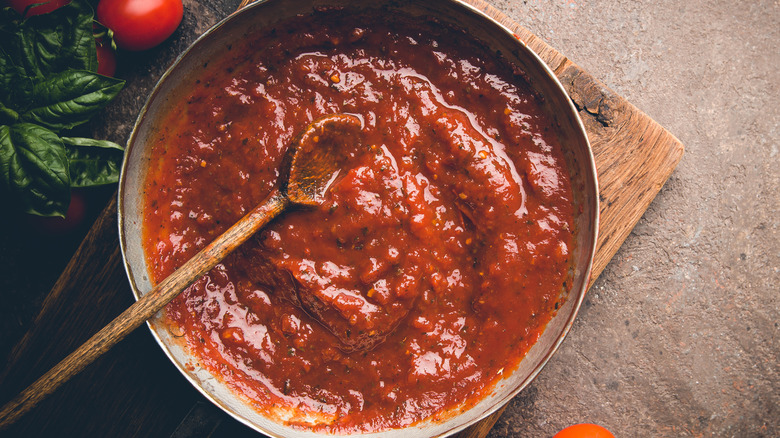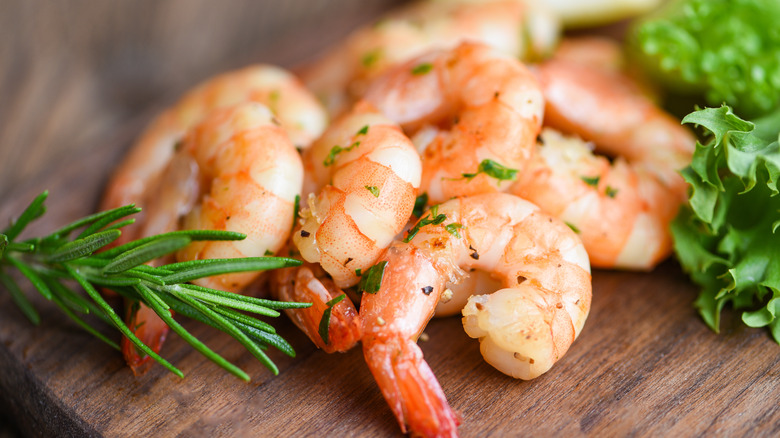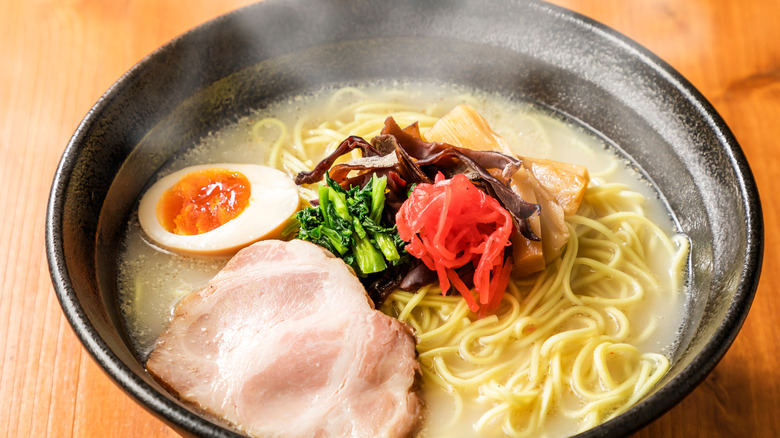15 Tips You Need When Cooking With Baking Soda
Sodium bicarbonate, sodium hydrogen carbonate, and NaHCO₃ — they're all synonyms for baking soda, that household staple none of us can live without. Whether you use it to give your baked goods lift, neutralize refrigerator odors, or clean kitchen appliances, probably not a day goes by without you reaching for this necessity. But just when you think you've discovered all of the wacky ways you can use baking soda around the house, we're here to tell you that you haven't seen anything yet.
In this article, we'll take you through several baking soda cooking tips you've never heard of. We start with the basics, like how to store it correctly and why it's important to keep your refrigerator baking soda and your cooking baking soda separate. Then, we illustrate all the ways you can use baking soda to speed up cooking time. We finish by providing some truly amazing baking soda tips, like how you can use it to transform pasta into ramen noodles. If it seems like there's no end to the number of ways you can use baking soda, then you're right. Read on to discover just how amazing this little product is.
1. Store your baking soda correctly
If you're like most people, you store baking soda in the same container it came in. Depending on the brand, that means a cardboard box or a resealable plastic bag. Although they're less common and more difficult to recycle, resealable plastic bags are the better option. They keep air away from the baking soda. The same can't be said for cardboard boxes.
With their open tops and flimsy packaging, cardboard boxes are basically the worst kind of container for storing baking soda. They let in all kinds of air, something that can cause sodium bicarbonate to clump like no one's business. If you've noticed lumps in your baking soda, swap out your box for an airtight container. While upgrading your storage solution helps you avoid clumpy baking soda, there is hope if yours has already gone hard. Pour your baking soda into a bowl and use a meat tenderizer to smash out the chunks. Alternatively, you can use a blender to break up rock-hard baking soda.
2. Keep your cooking baking soda separate from your deodorizing baking soda
Thanks to years of clever marketing, you're probably familiar with the idea of using baking soda to keep refrigerator odors at bay. This simple trick works thanks to some basic chemistry. Most fridge odors are the result of fatty acids being released when food goes bad. The nasty smells from these acids can be neutralized with a base. With a pH of 8.5, baking soda is just the substance for the job.
Baking soda might be the ideal compound for odor-fighting but it's important to remember that it can't do everything. Deodorizing baking soda should only be used for eliminating stinkiness, not for cooking. That's because it absorbs odors while simultaneously knocking them out. If you were to use your fridge baking soda for cooking, you could end up infecting your cookies or bread with foul food odors. An easy solution is to have two containers of baking soda on hand — one for the refrigerator and one for the cabinet.
3. Wash fruit and vegetables with baking soda
Your produce may look and feel clean, but is it really? We don't say that to scare you. Rather, our goal is to remind you of the importance of thoroughly washing fruits and vegetables before consuming them. Washing produce helps remove germ-containing dirt. While we all agree that washing fruits and veg is important, knowing the best way to tackle the task can be tough. For example, the USDA advises not to use dishwashing soap or produce wash for cleaning food. The Food and Drug Administration (FDA) doesn't regulate these products, so they're not safe to eat.
Using hot water is also less than ideal, as it can cause leafy greens to wilt. On the other side of the coin, cold water isn't effective enough when it comes to removing caked-on dirt or food wax. So, what's the solution? Making your own produce wash from water and baking soda. All you need to do is mix 3 to 4 tablespoons of baking soda with room-temperature water in a large bowl. Swirl your veggies around, then rinse. This easy trick works because baking soda is effective at dissolving food wax. Its alkaline structure also helps it remove dirt and grease.
4. Baking soda makes hard-boiled eggs easier to peel
Who hasn't experienced the hair-pulling frustration that comes with trying to peel a hard-boiled egg? If you're like us, you've tried every single tip out there to simplify this irritating task. From dunking eggs into an ice bath to rolling eggs on the counter, nothing seems to help. Thankfully, our egg-peeling woes are a thing of the past thanks to a baking soda hack.
The secret is adding a bit of baking soda to the cooking water. Cook the eggs as you normally do, then watch how easy it is to slough off the shells. You don't need much — about ½ teaspoon of baking soda per quart of water is all it takes. Perhaps the only downside of using this trick is that your eggs might have a stronger sulfur taste and smell than you're used to.
Understanding why this trick works requires knowing why shells stick to eggs in the first place. This happens because the albumen (aka egg white) has a low pH, making it acidic. When cooked, the egg whites cling to the keratin on the egg's inner membrane. Adding baking soda (a base) to the water increases the pH. As a result, the bond between the egg whites and the keratin weakens, simplifying your egg-peeling task.
5. Rub baking soda on meat to keep it tender
With meat prices reaching record highs, it makes sense to make the most out of whichever cuts your grocery budget allows for. Whether you find yourself buying tougher cuts or just want to up the quality of your usual purchases, tenderizing your meat before cooking is an excellent way to improve your eating experience. One of our favorite methods is one that might not come to mind right away — using baking soda.
That's right, this unsuspecting household staple is also the secret to melt-in-your-mouth meat. By covering meat with a layer of baking soda, you raise the pH of the meat's surface. This makes it more difficult for the proteins to form bonds, resulting in more tender and moist meat. For large pieces of meat, rub the exterior with baking soda and refrigerate it for 3 to 5 hours. Rinse and cook as you normally would. For small pieces, create a baking soda solution. To do this, dissolve 1 teaspoon of baking soda in ½ cup of water. This makes enough for 12 ounces of meat. Soak the meat for at least 15 minutes, then rinse and cook as desired.
6. Sprinkle a bit on your beans to make them cook faster
Versatile, cheap, and protein-packed, there's so much to love about beans. The only negative is that dried beans take forever to prepare. Sure, you can avoid a lot of hassle by purchasing canned beans, but dried beans are a way better value when it comes to price, flavor, and texture. But with soaking and cooking time, you're looking at a minimum of nine hours to prepare. Who's got time for that? Certainly not us. That is until we discovered a simple way to cook beans more quickly.
The trick, as you might have already guessed, has to do with baking soda. By adding baking soda to beans, you can halve their cooking time. To accomplish this, either soak beans in a baking soda-water solution prior to cooking or add a pinch of baking soda to the beans as they cook. Baking soda's alkaline properties break down the pectin in the beans, causing them to soften much more quickly.
7. Make polenta in half the time
Not only can baking soda halve the time it takes to whip up a batch of beans, but it can also reduce the time needed to make polenta. Without baking soda, this coarse, grainy cornmeal product can take up to 45 minutes to cook. Adding just a pinch of baking soda to the cooking water is enough to reduce polenta's cooking time to 25 minutes.
It may sound like sorcery, but we just take it as further proof of the fact that baking soda truly is a jack of all trades. Baking soda's slightly basic pH causes the pectin in the corn's cell walls to break down. Once these defenses are compromised, it's much easier for water to enter the cells and gelatinize the starch. The result is a super creamy, porridge-like dish. For the best results, stir ⅛ of a teaspoon of baking soda into your cooking water just before adding the polenta.
8. Caramelize onions more quickly with baking soda
We never get tired of looking for ways to save you time in the kitchen. To that end, we've got yet another tip for cooking with baking soda. This one has to do with caramelizing onions. Caramelized onions are rich, sweet, and savory all at the same time. On top of their delicious flavor profile, these culinary gems have a soft texture that adds depth to pretty much anything you put them on. From French onion soup to caramelized onion dip, everything is better with caramelized onions. The only problem? They take 45 minutes to cook. Not exactly ideal when you've got a hankering for some tasty alliums.
To satisfy your craving in record time, add ¼ teaspoon of baking soda per pound of onions. Doing so changes the pH of the mixture, causing a faster Maillard Reaction (aka the process responsible for caramelizing onions). Translation? You'll have delectable caramelized onions in about a third of the time.
9. Add a pinch to clarify sweet tea
Southerners take a lot of pride in their sweet tea. From choosing the best tea blends to selecting the freshest mint and lemon, no detail is overlooked. But even the most skilled tea masters can find themselves with a batch of cloudy tea from time to time. Cloudy tea is the result of over-brewing. When tea bags steep too long, the tannins and caffeine bind together, creating haziness.
Luckily, it's easy to fix this culinary oopsie. Mix ⅛ teaspoon of baking soda into your sweet tea and stir. With just this tiny amount, your pitcher will go from a cloudy mess to a perfectly clear ginger-colored masterpiece. Not only can baking soda clarify your sweet tea, but it can also eliminate the tannic bitterness that results from over-brewed tea. Of course, the best way to avoid cloudiness and bitterness is to steep your tea for the right amount of time (about 7 minutes), but it's comforting to have a quick fix in case things go sideways.
10. Substitute baking soda for lye when making soft pretzels
The secret to perfect homemade soft pretzels isn't salt, brown sugar, or even yeast. Nope, the ingredient that makes soft pretzels so great is lye. Strange as it may seem, this caustic alkaline chemical (which is also used for tanning animal hides and making soap) is what causes pretzels to brown quickly. It's also the ingredient responsible for creating the to-die-for flavor and shiny surface we've all come to know and love.
That's all well and good, but lye isn't exactly an easy substance to get your hands on. Some specialty cooking stores might stock food-grade lye. And you can probably find it online, but there's an easier (and safer) way to make soft pretzels that requires zero lye. When cooked in the oven for an hour, baking soda's pH increases. The resulting substance is sodium carbonate, an alkaline substance with a pH of 10. Although not quite as alkaline as lye (pH 13), it's a close enough substitute. Cooked baking soda can be used as a 1:1 lye substitute in whichever soft pretzel recipe you're using.
11. Make your potatoes snap with baking soda
Crispy on the outside, soft on the inside — that's the goal when it comes to making perfect roast potatoes. But this perfect spud texture isn't always easy to capture. Oftentimes, you'll end up with potatoes that are either too crunchy or too mushy. Picking the right potatoes is one essential step in attaining roasted potato nirvana. Starchy varieties like russet and Yukon gold are the best. Their exteriors easily form crispy crusts, while their interiors stay soft and smooth.
But picking the right spuds isn't enough. You have to parboil your starchy vegetables in a baking soda-water mixture before slipping them into the oven. Adding ½ teaspoon baking soda to the cooking water raises the pH. This causes the potato's pectin to break down, making the insides nice and fluffy. It also causes the starches to come to the surface, something that creates the crispy, brown exteriors you've been pining for. Drain the potatoes after parboiling for 10 minutes, then roast them as usual.
12. Upgrade your chicken
Prior to cooking or seasoning, rub a bit of baking soda into the chicken skin. This simple addition locks moisture into the meat and keeps the skin nice and crispy throughout the cooking process. A similar technique, called velveting, is common in Asian cooking. To try out this method, cover cut-up pieces of chicken breast with baking soda (¾ teaspoon for every 8 ounces). Refrigerate 30 minutes. Then, rinse and dry the chicken before stir-frying. Adding baking soda helps tenderize the meat and keeps it from drying out under the high cooking temperature.
Alternatively, you can use this technique when making slow-cooker chicken. For two pounds of chicken breasts, you'll need ¼ cup of flour and 1 teaspoon of baking soda. Mix the dry ingredients together in a sealable plastic bag and toss the cubed chicken inside to coat. Next, cook the chicken in oil over medium-high for a couple of minutes, then toss it into a slow cooker for 30 minutes.
13. Reduce the acidity in tomato dishes with baking soda
We've all been there before. You've spent hours cutting up vegetables for your mirepoix, diced tomatoes, and prepared fresh herbs. All of the ingredients are mixed together beautifully, the aroma is heavenly, and the taste is ... bitter. Despite your best efforts, your marinara has turned into an acidic slop. There are lots of possible reasons why your tomato sauce has turned tart. One is that the tomatoes are acidic. This happens when they're not ripe or when you select the wrong type for sauce-making. Another possibility is that you added herbs too early in the cooking process. Herbs like sage, oregano, and basil become bitter when cooked too long.
Whatever the reason, you need a way to fix your bitter tomato sauce fast. Our go-to method is adding a pinch of baking soda to the sauce. Stir a few times and taste to see if there's an improvement. If your sauce is still too acidic, add a bit more baking soda. This technique works because baking soda's alkalinity balances out the acidity from the tomatoes, creating a more neutral flavor.
14. Baking soda gives your shrimp some snap
From shrimp burgers and gumbo to po'boys and shrimp cocktails, there are countless ways to enjoy shrimp. But this crowd-favorite is tough to get right. Cook them for too long and you're left with tough, rubbery seafood. Undercook them and you'll find yourself with fleshy, spongy shrimp. Worst of all, select the wrong shrimp and you'll be biting into a mushy mess. While proper shrimp selection and cooking go a long way, there's one more thing to do if you want crispy shrimp every time.
The secret is to dunk raw shrimp in a brine of water, salt, and baking soda for 15 minutes to one hour before cooking. Salt keeps moisture inside, while baking soda gives shrimp a bit of snap. The mechanics behind why this works are fascinating. Baking soda causes the shrimp's muscles to release an electric charge and spasm. This spasm causes the muscle fibers to separate, which in turn keeps moisture inside the fibers. As is often the case when it comes to cooking with baking soda, you don't need much. About ¼ teaspoon per pound of shrimp is all it takes.
15. Transform pasta into ramen noodles using baking soda
Love ramen but don't have access to an Asian grocery store? Not to fear, there's a simple way to transform your angel hair or spaghetti into ramen-ready noodles. Simply add a bit of baking soda to the pasta water during cooking. That said, the jury is out when it comes to the exact amount of baking soda to add. Some recommend using as little as 2 teaspoons per quart of water, while others suggest adding 1 tablespoon. The final amount is up to you, but our recommendation is to start with as little as possible, then add more if needed.
If you're curious as to why the simple addition of baking soda can turn your Italian pasta Japanese, the answer is once again food chemistry. Ramen noodle dough contains kansui, an alkaline mineral water responsible for ramen noodles' yellow color and springy texture. Adding another alkaline ingredient, such as baking soda, to your pasta water mimics the effect of kansui.
Static Media owns and operates Tasting Table, Mashed, and The Daily Meal.
